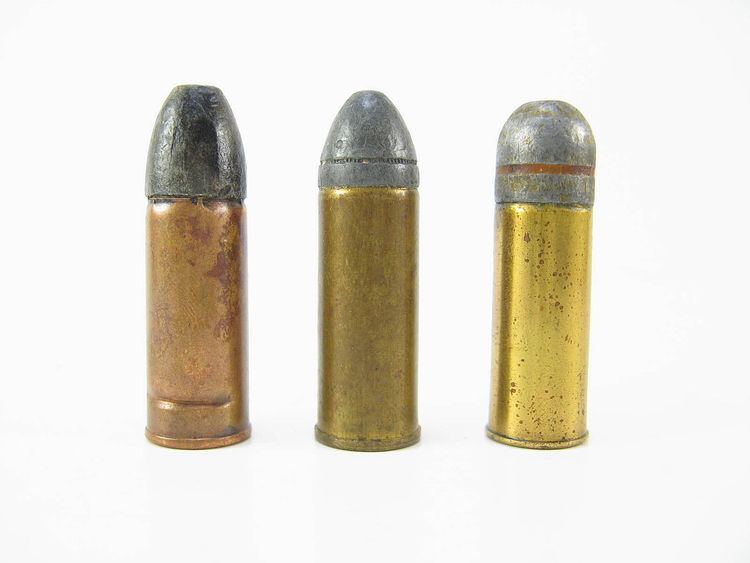Type Revolver In service 1871-1873 Produced 1871?-1940? | Place of origin US Bullet diameter .451 in (11.5 mm) | |
 | ||
The .44 Colt was an American centerfire revolver cartridge produced commercially from 1871 until the 1940s.
Contents
History
The cartridge was developed for the United States Army, and introduced by Colt's Patent Firearms around 1871. The Army used it until 1873, at which time it was replaced by the better known .45 Colt cartridge used in the recently adopted Colt Single Action Army revolver.
The .44 Colt was used in the Richards-Mason conversions of Colt's 1860 Army percussion revolver. The conversion process involved boring through the chambers of the obsolete cap and ball revolvers to enable them to chamber centerfire metallic cartridges.
This process left a chamber of uniform diameter, with no step at the front. Thus the bullet and the brass case were made the same diameter, with a short "heel" section at the base of the bullet of smaller diameter to inserted in the mouth of the case.
Modern .44 Colt ammunition is dimensionally similar to .44 Special with regard to bullet diameter and case width, the main exceptions being the shorter case length and smaller rim diameter.
Ballistics
The original .44 Colt loading used a heeled, outside lubricated bullet. The major diameter of the bullet was approximately the groove diameter (.451") of the converted ".44" cap and ball revolver. The smaller "heel" at the base of the bullet was sized to fit inside the brass case at approximately .430".
Upon firing, the ductile soft lead bullet (alloys of pure to nearly pure lead were used) allowed the base of the bullet to "bump up" to first the chamber diameter in the cylinder, then jump the gap, through the forcing cone into the rifling. This is effective with black powder, but less so with Smokeless powder. Alloying the lead with tin or antimony to harden it makes this nearly impossible. Use of hard alloys typically leads to poor accuracy.
Benet cup and Martin-type primers were later replaced by more reliable Boxer type primers.
The ballistic performance of the original .44 Colt is comparable to the .44 Remington, and less powerful than modern .44 Russian loads. Cases for the modern ".44 Colt" chambered handguns are typically made using trimmed .44 Magnum, .44 Special, or .44 Russian brass and a historically inaccurate .429 lead bullet. (As opposed to the older "heeled bullets" with a larger .451" diameter outside lubricated bullet.).
Commercial black powder and smokeless ammunition remained available until around 1940, by which time the .44 Colt had been entirely supplanted by more modern handgun cartridges such as the .38 Special and .44 Special.
The modern sport of Cowboy Action Shooting has stimulated renewed interest in obsolete revolver cartridges like .44 Colt and, for the first time in nearly 100 years, commercially produced .44 Colt ammunition is available. Brass is available from Starline and can be made by trimming the length of .44 Special cases.
